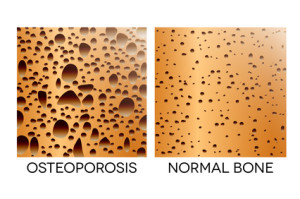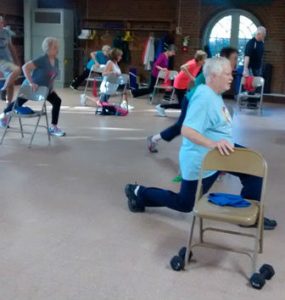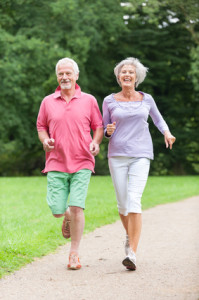
Often called the “silent disease,” osteoporosis is approaching epidemic proportions. Twelve million Americans have osteoporosis, and an estimated 37 million (80% of women) have low bone density, a strong risk factor for the disease. Men and women from all races and backgrounds can develop osteoporosis. Osteoporosis drains bones of mineral content, and although the disease often has no symptoms, it causes more than 1.5 million fractures each year.
So, what causes osteoporosis? The cause can be linked to several things such as age, gender, heredity, nutrition, lack of exercise and menopause. The primary cause of osteoporosis is related to the dramatic decrease of estrogen in post-menopausal women. Estrogen is responsible for inhibiting excessive bone breakdown and balancing the levels of calcium available to the bones. Your bones are living tissue which absorb calcium through the blood and store it in the bones which causes an increase in bone density. When the blood level calcium decreases or is disturbed through lack of estrogen, the result is the loss of bone tissue.
What happens when your bone density decreases? Because the bones are unable to absorb calcium, your bones may become weak and brittle to the point when your bones fracture or crack. Unfortunately, many times osteoporosis is not detected until a fracture has occurred. Fractures usually occur in the wrists, spine or hips. This is because these areas are made up of the most porous and metabolically active bone tissue in the body known as trabecular bone. A fracture means loss of independence and functional capacity, severe pain and even death. Hip fracture complications can be fatal.
 To increase bone density, you must exercise your bones which means you must impart mechanical forces to the bones. This is done in one of two ways: gravitational support of the body weight by the skeleton is the natural way and its effectiveness is based on your body weight. People who are overweight actually have denser bones because of the increased amount of body weight their skeleton has to support. This is probably the only advantage to being overweight, however, eventually the decrease in estrogen will cause the bones to break down faster than it can rebuild itself and osteoporosis will occur!
To increase bone density, you must exercise your bones which means you must impart mechanical forces to the bones. This is done in one of two ways: gravitational support of the body weight by the skeleton is the natural way and its effectiveness is based on your body weight. People who are overweight actually have denser bones because of the increased amount of body weight their skeleton has to support. This is probably the only advantage to being overweight, however, eventually the decrease in estrogen will cause the bones to break down faster than it can rebuild itself and osteoporosis will occur!
The only other way to impart mechanical forces on the bones and exercise the bones would be through muscular force resulting from the contraction of muscles attached to the skeleton. This type of stress can only occur through resistance training which primarily consists of exercising with resistance machines or doing weight training exercises with free weights. Like muscles, bones respond to this type of stress and become bigger and stronger. In addition, resistance training will increase the blood flow to the bones and results in hormonal changes which enhance bone nutrition and growth.
If you show signs such as stooped posture, fractures, or stress fractures, you should contact your physician for a bone mineral density test. Risk factors that may increase your risk for developing osteoporosis are:
- Family history of osteoporosis
- Decrease of estrogen production caused by menopause
- Hysterectomy without ongoing estrogen replacement
- Lack of regular exercise
- Smoking and second-hand smoke
- Calcium deficiency
- Excess alcohol consumption
- Taking corticosteroid medications or regular use of steroids
- Cushing’s Syndrome (which is abnormally high levels of natural steroids in the body)
There is no cure for osteoporosis, but exercise and diet are keys to prevention and may even reverse some bone mass loss. Calcium supplements are a good idea, however, osteoporosis may begin as early as your mid-thirties and, therefore, early intervention is a must. Besides sufficient calcium intake, vitamin D plays a major role in calcium absorption. The recommended daily intake for vitamin D is 400 international units (iu). Additionally, supplements have been proven mostly ineffective if not taken in conjunction with an exercise routine. Exercise enhances the bones’ ability to utilize dietary and supplemental calcium, thus the best way to reduce your risk of developing osteoporosis is to start at an early age making sure you take in 800-1,500 milligrams of calcium per day, 400 iu’s of Vitamin D per day and exercise regularly. Additionally, refraining from smoking and excessive alcohol use is vital.
 Here are some tips:
Here are some tips:
- Eat a calcium rich diet including dairy, broccoli, kale, blackstrap molasses and dried beans
- Increase Vitamin D intake with liver, cod liver oil, egg yolks, fortified milk and cereals
- Participate regularly in weight-bearing exercises such as walking
- Work out with free weights or resistance machines 2-3x a week resting at least one day between workouts
- Undergo annual bone density screenings to monitor bone loss
For more information on Osteoporosis, check out these organizations’ websites:
- Foundation for Osteoporosis Research and Education (FORE): www.fore.org
- International Council on Active Aging (ICAA):www.icaa.cc
- International Osteoporosis Foundation (IOF): www.osteofound.org
- National Institute of Arthritis, & Musculoskeletal (NIAMS): www.niams.nih.gov/Health_Info/
Bone/ - National Osteoporosis Foundation (NOF): www.nof.org
- Geri-Fit Strength Training Fitness Products and DVDs: www.gerifit.com
Francesca Fisher is a Certified Senior Strength Training Specialist and the creator of the Geri-Fit® evidence-based strength training workout for older adults. The exercise program is offered nationwide at senior centers, non-profits, churches, and YMCAs. For more information, visit gerifit.com
